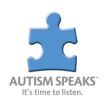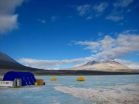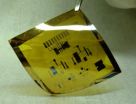(Press-News.org) SALT LAKE CITY— Discovery of a new drug with high potential to treat Ewing sarcoma, an often deadly cancer of children and young adults, and the previously unknown mechanism behind it, come hand-in-hand in a new study by researchers from Huntsman Cancer Institute (HCI) at the University of Utah. The report appears in today's online issue of the journal Oncogene.
"Ewing sarcoma is almost always caused by a cancer-causing protein called EWS/FLI," said Stephen Lessnick, M.D., Ph.D., director of HCI's Center for Children's Cancer Research, professor in the Department of Pediatrics at the University of Utah School of Medicine, and an HCI investigator.
In the lab, Lessnick and his colleagues found that an enzyme, called lysine specific demethylase (LSD-1), interacts with EWS/FLI to turn off gene expression in Ewing sarcoma. By turning off specific genes, the EWS/FLI-LSD1 complex causes Ewing sarcoma development. "This makes LSD-1 an important target for the development of new drugs to treat Ewing sarcoma," Lessnick said.
"For a long time, we've known that EWS/FLI works by binding to DNA and turning on genes that activate cancer formation," said Lessnick. "It was a surprise to find out that it turns genes off as well.
"The beauty, if there's anything beautiful about a nasty disease like this, is that if we can inhibit EWS/FLI, we can inhibit this cancer, because EWS/FLI is the master regulator of Ewing sarcoma," Lessnick added.
While Lessnick and his colleagues worked on EWS/FLI in their basic science lab, Sunil Sharma, M.D., director of HCI's Center for Investigational Therapeutics, professor in the Department of Medicine at the University of Utah, and an HCI investigator, had already focused on LSD-1 as a possible target for new cancer treatments and had been working for several years to design drugs that would inhibit its actions.
"We had found that LSD-1 was important for regulation of a variety of properties in several different cancers, including acute leukemias, breast and prostate cancers," Sharma said.
"After Steve showed that LSD-1 was directly regulating the function of EWS/FLI, we teamed up with him to see whether the LSD inhibitors we had discovered worked in Ewing sarcoma models," Sharma said. "Our tests in Ewing sarcoma tissue cultures show they are extremely potent."
Lessnick and Sharma are now working together to further test LSD inhibitors in animal models as they work toward approval of a first-in-man clinical trial. In addition, Lessnick's basic science research on LSD-1 in Ewing sarcoma continues. "We think it may play a larger role in Ewing sarcoma than simply turning off a handful of genes, and we're looking into that," said Lessnick.
"This is a great example of how collaboration between the therapeutics and basic science programs can lead to new treatments for patients—one of HCI's highest goals," said Sharma.
###
Graduate student Savita Sankar of the Lessnick lab was instrumental in this research; her work is supported by the Howard Hughes Medical Institute (HHMI) under the University of Utah Med into Grad Program. This work was also supported by NIH/NCI grants R01 CA140394 and P30 CA042014, as well as funding from the Imaging, Diagnostics, and Therapeutics Program at Huntsman Cancer Institute. Work in the Lessnick lab is also supported by Sydney's Incredible Defeat of Ewing's Sarcoma (SIDES).
The mission of Huntsman Cancer Institute (HCI) at the University of Utah is to understand cancer from its beginnings, to use that knowledge in the creation and improvement of cancer treatments, to relieve the suffering of cancer patients, and to provide education about cancer risk, prevention, and care. HCI is a National Cancer Institute-Designated Cancer Center, which means that it meets the highest national standards for cancer care and research and receives support for its scientific endeavors. HCI is also a member of the National Comprehensive Cancer Network (NCCN), a not-for-profit alliance of the world's leading cancer centers that is dedicated to improving the quality and effectiveness of care provided to patients with cancer. For more information about HCI, please visit www.huntsmancancer.org.
Possible new treatment for Ewing sarcoma
2012-11-27
ELSE PRESS RELEASES FROM THIS DATE:
Bioengineered marine algae expands environments where biofuels can be produced
2012-11-27
Biologists at UC San Diego have demonstrated for the first time that marine algae can be just as capable as fresh water algae in producing biofuels.
The scientists genetically engineered marine algae to produce five different kinds of industrially important enzymes and say the same process they used could be employed to enhance the yield of petroleum-like compounds from these salt water algae. Their achievement is detailed in a paper published online in the current issue of the scientific journal Algal Research.
The ability to genetically transform marine algae into ...
Students at cooperative schools are more engaged
2012-11-27
This press release is available in Spanish.
Student engagement is not independent of the type of school attended.Nor is it independent of the organisational development of the school.The school's organisational style affects the work of its teaching staff, which, in turn, has repercussions on the performance and engagement of their students.As IkerRos, the UPV/EHU researcher, has been able to verify in his PhD thesis, these factors vary when comparing public schools, subsidised schools and co-operative schools, the latter being the ones that fare best.
"The study of ...
Dramatic rise in autism prevalence parallels research explosion
2012-11-27
(NEW YORK, N.Y., November 26, 2012) – Autism Speaks Chief Science Officer Geraldine Dawson, Ph.D. describes how the dramatic progress in autism research has paralleled increased recognition of autism's prevalence and financial impact in the December issue of the Archives of General Psychiatry published on line today. "This issue of the journal features three articles on autism," she writes in her editorial. "A decade ago, the journal published about the same number of autism articles per year."
Dr. Dawson also notes that, while the funding for autism research has dramatically ...
University of Maryland School of Medicine, NIH study pinpoints brain area's role in learning
2012-11-27
An area of the brain called the orbitofrontal cortex is responsible for decisions made on the spur of the moment, but not those made based on prior experience or habit, according to a new basic science study from substance abuse researchers at the University of Maryland School of Medicine and the National Institute on Drug Abuse (NIDA). Scientists had previously believed that the area of the brain was responsible for both types of behavior and decision-making. The distinction is critical to understanding the neurobiology of decision-making, particularly with regard to substance ...
Algae Biomass Organization hails new UCSD study showing saltwater algae viable for biofuels
2012-11-27
SAN DIEGO, Calif. (November 26, 2012) The Algae Biomass Organization, the trade association for the U.S. algae industry today hailed the findings of a University of California at San Diego study that concludes, for the first time, that marine (saltwater) algae can be just as capable as freshwater algae in producing biofuels. The research is documented in a peer-reviewed paper published online in the current issue of the scientific journal Algal Research.
"What this means is that you can use ocean water to grow the algae that will be used to produce biofuels. And once ...
Hearty organisms discovered in bitter-cold Antarctic brine
2012-11-27
EAST LANSING, Mich. — Where there's water there's life – even in brine beneath 60 feet of Antarctic ice, in permanent darkness and subzero temperatures.
While Lake Vida, located in the northernmost of the McMurdo Dry Valleys of East Antarctica, will never be a vacation destination, it is home to some newly discovered hearty microbes. In the current issue of the Proceedings of the National Academy of Sciences, Nathaniel Ostrom, Michigan State University zoologist, has co-authored "Microbial Life at -13ºC in the Brine of an Ice-Sealed Antarctic Lake."
Ostrom was part ...
Alaska's iconic Columbia Glacier expected to stop retreating in 2020, says CU-Boulder study
2012-11-27
The wild and dramatic cascade of ice into the ocean from Alaska's Columbia Glacier, an iconic glacier featured in the documentary "Chasing Ice" and one of the fastest moving glaciers in the world, will cease around 2020, according to a study by the University of Colorado Boulder.
A computer model predicts the retreat of the Columbia Glacier will stop when the glacier reaches a new stable position -- roughly 15 miles upstream from the stable position it occupied prior to the 1980s. The team, headed by lead author William Colgan of the CU-Boulder headquartered Cooperative ...
Gastric bypass surgery helps diabetes but doesn't cure it
2012-11-27
SEATTLE—After gastric bypass surgery, diabetes goes away for some people—often even before they lose much weight. So does that mean gastric surgery "cures" diabetes? Not necessarily, according to the largest community-based study of long-term diabetes outcomes after bariatric surgery. For most people in the study, e-published in advance of print in Obesity Surgery, diabetes either never remitted after gastric surgery or relapsed within five years.
Among the two thirds of the study's patients whose diabetes at first went away, more than a third re-developed diabetes again ...
To get the best look at a person's face, look just below the eyes, according to UCSB researchers
2012-11-27
They say that the eyes are the windows to the soul. However, to get a real idea of what a person is up to, according to UC Santa Barbara researchers Miguel Eckstein and Matt Peterson, the best place to check is right below the eyes. Their findings are published in the Proceedings of the National Academy of Sciences.
"It's pretty fast, it's effortless –– we're not really aware of what we're doing," said Miguel Eckstein, professor of psychology in the Department of Psychological & Brain Sciences. Using an eye tracker and more than 100 photos of faces and participants, Eckstein ...
Penn researchers make flexible, low-voltage circuits using nanocrystals
2012-11-27
PHILADELPHIA — Electronic circuits are typically integrated in rigid silicon wafers, but flexibility opens up a wide range of applications. In a world where electronics are becoming more pervasive, flexibility is a highly desirable trait, but finding materials with the right mix of performance and manufacturing cost remains a challenge.
Now a team of researchers from the University of Pennsylvania has shown that nanoscale particles, or nanocrystals, of the semiconductor cadmium selenide can be "printed" or "coated" on flexible plastics to form high-performance electronics.
The ...




